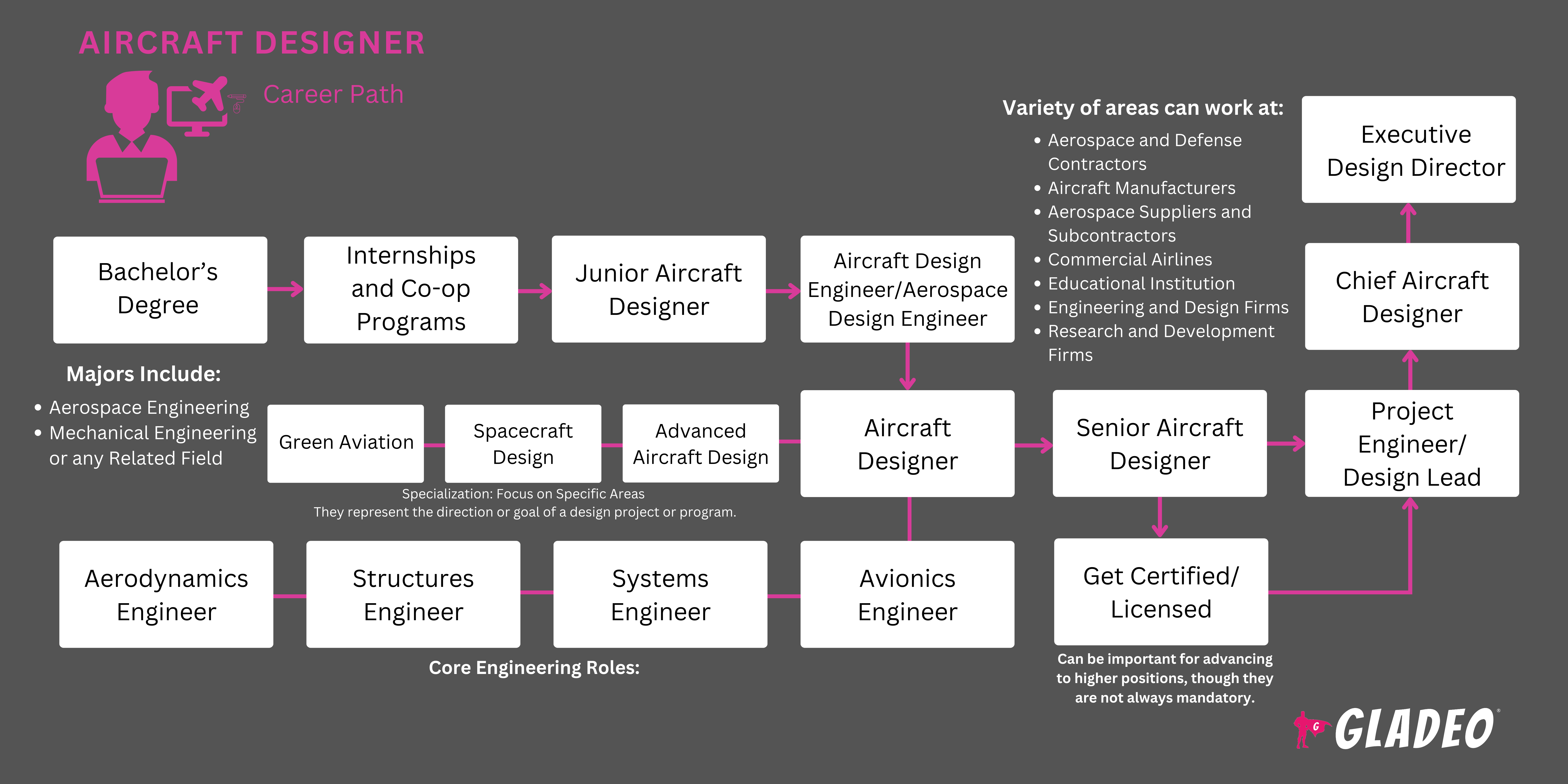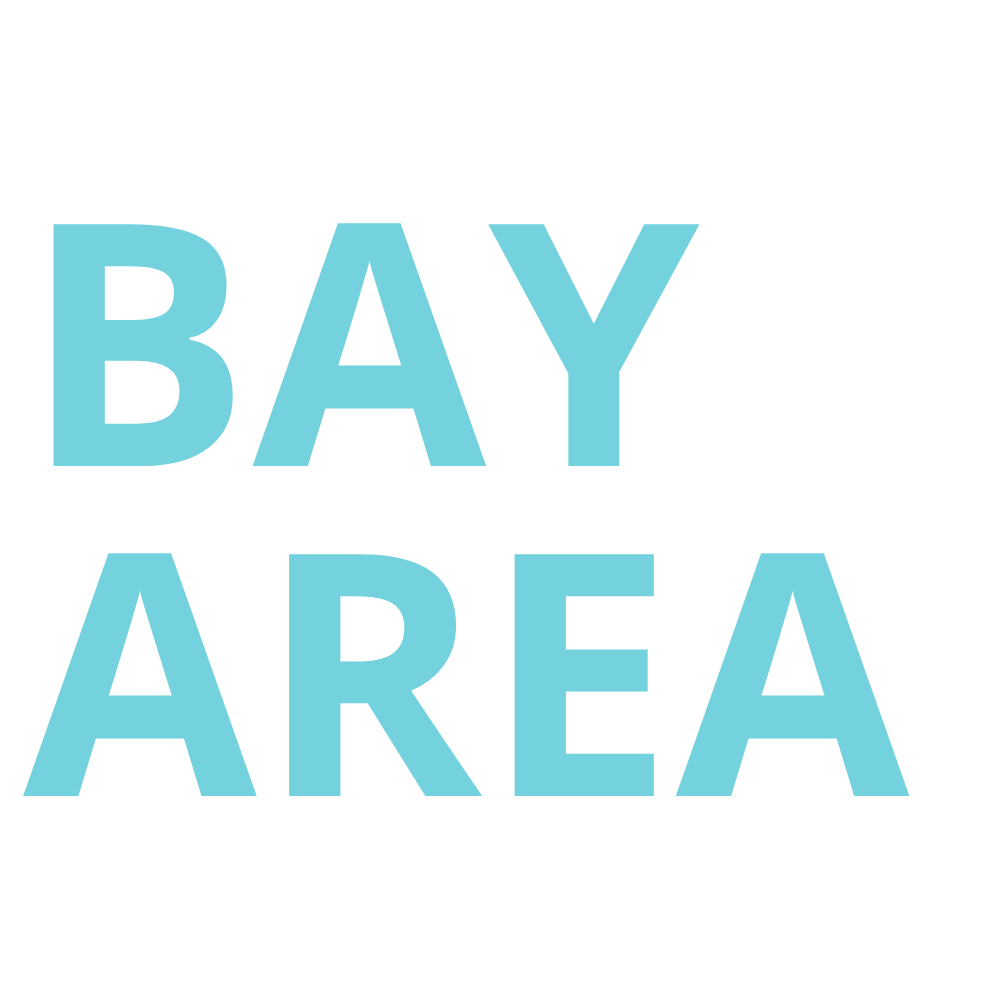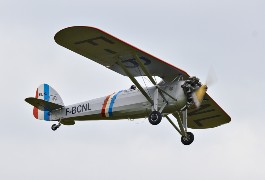聚光灯
航空航天工程师、飞机工程师、飞机系统设计师、航空航天设计工程师、航空工程师、飞机设计与开发工程师
仅在美国,民用和军用航空机队就拥有约22万架飞机——而这仅占全球总量的极小部分!每年,众多飞机设计都会根据空气动力学、材料科学、结构分析和推进技术领域的最新成果进行审查与升级。这项复杂工作由专业的飞机设计师与工程师、制造商及政府机构通力协作完成。
从商用飞机和军用喷气机到直升机和无人机,飞机设计师们致力于解决诸多挑战:提升燃油效率、增强性能、降低噪音,并提高结构完整性和安全性。当然,他们还必须确保设计方案既可行又符合法规要求。
一旦初步设计方案获得批准,飞机设计师便会运用先进的建模与仿真软件工具,在实体原型制造前对设计方案进行假设性条件下的测试。从概念阶段到实际生产并投入现实世界使用,全新"白板设计"的开发过程可能耗时数年。
- 致力于创新型高性能飞机的设计工作
- 推动航空技术进步
- 参与各类项目工作的机会
- 与多学科专家团队合作
工作日程
- 飞机设计师通常从事全职工作,每周工作时间常超过40小时。他们可能需要加班以满足项目截止期限或解决设计问题。
典型职责
- 参与现有设计的评审并提供技术专长
- 与利益相关方会面,审议新设计项目或修订设计项目的目标、预算及时间框架。
- 运用计算机辅助设计软件开发并优化飞机设计方案
- 创建详细的技术图纸和文档
- 与制造团队协调,确保可行性、效率及按时交付
- 向利益相关方展示设计方案。整合反馈意见,确保符合航空安全法规与标准。
- 进行仿真、应力测试和风洞试验,以分析空气动力学特性、验证设计性能,并评估材料的重量、耐久性和成本效益。
- 管理设计迭代并维护文档的版本控制
- 与工程师协作,整合系统、组件及先进技术,例如航空电子设备和推进系统。
- 评估环境影响并致力于环保设计方案
- 对现有设计进行失效分析并开展改进工作
额外职责
- 通过课程和认证参与持续的专业发展
- 参加行业会议和研讨会,以掌握最新趋势
- 与大学和研究机构开展合作
- 发表研究成果并为行业期刊撰稿
- 指导初级设计师。领导跨职能团队完成大型项目。
- 在制造和测试阶段提供技术支持
- 参与制定公司设计标准与最佳实践
- 为营销和销售团队提供技术信息支持
软技能
- 注重细节
- 沟通
- 创造力
- 批判性思维
- 决策
- 创新
- 耐心
- 劝说
- 问题解决
- 团队合作
- 时间管理
技术技能
- 二维图形设计工具:Adobe Illustrator、Photoshop 和 InDesign
- 项目管理软件:Microsoft Project、Trello 或 Asana
- 协作工具:Slack 或 Microsoft Teams
- 计算机辅助设计与三维建模:AutoCAD、CATIA、SolidWorks、Rhino及西门子NX
- 计算机辅助制造
- 计算机数控(CNC)加工
- 电气系统与集成:Altium Designer、EAGLE 和 Mentor Graphics
- 人体工程学与人因工程学
- 人机界面设计:Sketch、Adobe XD 或 Axure RP
- 材料知识:金属、复合材料、塑料及其在制造过程中的应用
- 制造限制与精益生产原则
- 真实感渲染与动画制作:KeyShot、V-Ray 或 Lumion
- 产品生命周期管理:西门子Teamcenter或PTC Windchill
- 航空监管标准与合规
- 仿真软件:ANSYS、Simulink和MSC Nastran,用于结构完整性、空气动力学及碰撞安全测试
- 声音设计与声学:EASE 或 SoundPLAN
- 曲面建模:ICEM Surf 或 Alias Surface
- 可持续发展与生态设计
- 技术绘图与建模:Alias、Blender 和 DraftSight
- 车辆动力学与工程:空气动力学、结构分析、推进系统及航空电子设备
- 虚拟与增强现实工具:Unity、虚幻引擎或Autodesk VRED
- 航空航天制造商和供应商
- 商业航空公司
- 国防承包商
- 教育机构
- 工程与设计公司
- 政府机构
- 私营航空航天公司
- 研发公司
飞机设计师在充满活力的工作环境中从事尖端项目。他们必须与团队协作,产出高度精准、可靠的设计方案,确保符合严格的安全与性能标准。该职位要求具备一丝不苟的细节把控能力,并持续进行专业发展,以跟上不断演进的航空技术与法规。
这份工作有时需要长时间工作,而满足严格标准的压力对某些员工来说相当严苛。然而,许多设计师却热爱技术挑战与创意机遇的融合。当看到自己的设计最终实现时,他们会获得极大的满足感——尤其是在历经多年努力之后。
飞机设计领域的一大趋势是采用轻质复合材料,这类材料能减轻重量并提升燃油效率。另一趋势则是开发电动和混合动力推进系统,这些系统有望成为传统发动机的替代方案,实现更安静、更清洁、更高效的运行。先进的航空电子设备和自动化技术也在重塑设计行业,同时提升安全性并减轻飞行员工作负荷。设计师必须在设计过程中紧跟这些及其他技术进步,以助力提升可持续性。
飞机设计师们常热衷于制作和飞行模型飞机,尝试各种设计和机械结构,并积极参与科学博览会、机器人俱乐部等STEM相关活动。
- 飞机设计师通常拥有航空航天工程、机械工程或相关领域的学士学位(某些情况下为硕士学位)。
- 部分学生主修机械工程,辅修航空航天工程。
- 完成双学位项目(学士/硕士)可能有助于节省时间和金钱。
- 请注意,部分设计师并非工程师。他们虽来自工业设计领域,但会与工程师紧密合作,以确保设计方案在技术上可行。
- 对于没有工程学位的人士,专业课程和认证可能提供足够的技术知识,同时通过实习、合作项目或实践项目获得实际行业经验。
- 正如《飞行杂志》所指出的:“多数职位要求拥有工程或科学领域的学士学位,涵盖范围广泛,除航空航天专业外,还包括机械工程、电气工程、结构工程、材料工程乃至土木工程等。其他岗位可能需要系统安全、人因工程、航空器集成或美学设计方面的培训。该领域从业者普遍需具备CAD/CAM和数控加工的培训背景与操作能力。”
- 有志成为飞机设计师的相关课程包括:
- 航空航天结构
- 空气动力学
- 推进系统
- 飞机性能与设计
- 飞行力学
- 航空电子系统
- 航空航天材料科学
- 计算流体力学(CFD)
- 有限元分析(FEA)
- 飞机系统与控制
- 工程设计原理
- 航空安全标准与法规
- 可持续设计与环保实践
- 技术制图与三维建模
- 虚拟现实与增强现实技术在设计中的应用
- 实习或合作教育项目提供宝贵的实践经验和动手学习机会。
- 可提升个人资质的选修认证包括:
- 增材制造认证
- 飞机认证专家
- AS9100认证(航空航天质量管理体系认证)
- 认证航空航天技术员
- 认证CAD专业人员
- CATIA认证助理工程师
- 认证复合材料技术员
- 注册专业工程师
- SolidWorks认证专家
- 认证系统工程专业人员
- 项目管理专业人士
- 六西格玛认证
- 可持续设计认证
- 及时掌握不断发展的技术和法规至关重要,可通过参加专业发展研讨会或课程实现。
- 加入美国航空航天学会或航空航天工程师协会等专业组织,可提供建立人脉的机会并参与行业活动。
- 选择适合您需求的课程形式(校内授课、在线授课或混合授课)。
- 选择一所拥有强大航空航天工程、机械工程或相关专业课程的学校,该校应具备经ABET认证的项目、资金充足的实验室、研究机会、实习岗位以及与行业合作伙伴的校企合作项目。
- 权衡学费成本与可获得的经济援助及奖学金机会。
- 评估教师资质与校友成就。
- 考虑毕业后的就业情况,例如就业率。
- 专注于艺术、设计及STEM课程,包括微积分、微分方程、线性代数、统计与概率、数值方法、工程数学、复变函数、物理学和计算机科学。
- 研究飞机设计的历史沿革、存在的问题及解决方案。回顾最具创新性的设计及其成功原因。
- 考虑你想要设计的飞机类型,或者你是否只想专注于飞机的某个特定部件。
- 加入工程社团,参与科学展览会和竞赛活动
- 寻求在设计工作室或飞机制造厂的实习机会、兼职工作、合作教育项目、导师指导机会或学徒职位。
- 记录你的工作和学术成就,用于简历和大学申请,并建立一个包含项目和研究经历的作品集。
- 通过阅读《飞机设计》等期刊文章或观看科普视频,随时掌握行业趋势与技术进展。
- 联系一位在职的飞机设计师进行一次信息性访谈。看看能否跟随他们工作一天。
- 加入在线飞机设计相关讨论组及专业组织,例如美国航空航天学会。
- 浏览职位发布并阅读职位描述,了解雇主当前寻求的资质和专业领域。
- 成为飞行员并非成为优秀飞机设计师的必要条件,但持有私人飞行员执照能体现对航空业的投入。

- 这类工作机会往往通过人脉网络获得,因此请参加航空相关活动来拓展人脉。
- 创建专业的领英个人资料和网站来展示您的作品
- 研究潜在雇主并访问其招聘页面查看职位空缺
- 美国航空器设计师的主要雇主包括波音公司、洛克希德·马丁公司、诺斯罗普·格鲁曼公司、雷神技术公司、通用动力公司、美国国家航空航天局、湾流宇航公司、德事隆航空公司、蓝色起源公司和SpaceX公司。
- 注意,你可能需要搬迁到工作机会集中的地方!
- 保持耐心。申请实习、学徒、合作教育项目和初级职位。
- 请咨询您的学术项目经理,了解他们是否与当地雇主或招聘机构有合作关系。
- 在Indeed、LinkedIn和Glass door等招聘门户网站上浏览职位信息
- 使用飞机设计师简历模板获取排版和措辞的灵感
- 包含相关简历关键词,例如:
- 3D建模
- 先进复合材料
- 空气动力学
- 航空航天工程
- 飞机系统集成
- 计算机辅助设计
- CATIA
- 飞行力学
- 材料科学
- 机械工程
- 产品生命周期管理
- 推进系统
- 原型制作
- 合规管理
- SolidWorks
- 应力分析
- 热分析
- 风洞试验
- 与您的主管讨论晋升机会
- 参与具有挑战性的项目,展现你的技能和适应能力
- 主动寻求额外的教育和培训,以促进个人职业发展并为雇主创造价值。
- 随时掌握最新的软件、工具和方法论
- 考虑获取专业认证,例如:飞机认证专家、AS9100认证、认证航空航天技术员、认证CAD专业人员或注册专业工程师。
- 攻读研究生学位,深化专业造诣
- 探索飞机设计的不同领域以拓展专业知识。例如,若您通常只从事飞机设计工作,不妨尝试设计直升机或无人机。
- 前往其他国家了解其设计课程与风格。研究业内顶尖设计师的作品。
- 与同事、经理和利益相关者建立牢固的关系
- 指导初级同事或实习生培养领导能力
考虑更换雇主以促进职业发展。迁往以航空制造业岗位闻名的城市,例如华盛顿州西雅图、堪萨斯州威奇托、得克萨斯州沃斯堡、佐治亚州萨凡纳、阿拉巴马州莫比尔以及加利福尼亚州长滩。 - 积极参与专业协会活动,拓展人脉并提升声誉。参加行业会议,主动担任委员会职务,并向行业期刊或出版物投稿学术文章。
网站
- 航空航天美国
- 航空航天工业协会
- 航空航天制造与设计
- 航空航天测试国际
- 空客技术出版物
- 飞机拥有者与飞行员协会
- 美国航空航天学会
- 美国机械工程师学会
- 国际无人系统协会
- 《航空周刊与空间技术》
- 波音创新季刊
- 加拿大航空航天学会
- 国防高级研究计划局
- 防务新闻
- 欧洲航天局
- 实验飞机协会
- 联邦航空管理局
- 《飞行国际》
- 航空航天研究所
- 电气与电子工程师协会 航空航天与电子系统学会
- 机械工程师学会
- 国际航空科学理事会
- 国际系统工程理事会
- 国际航空航天工程学报
- 航空航天工程学报
- 航空航天信息系统杂志
- 飞机杂志
- 推进与动力学杂志
- 航天器与火箭杂志
- 美国国家航空航天局
- 皇家航空学会
- 航空航天工程师协会
- 航空航天公司
- 垂直飞行协会
书籍
- 《工程师的空气动力学》约翰·伯廷与罗素·卡明斯著
- 飞机设计:概念化方法,丹尼尔·P·雷默著
- 《飞行入门》,玛丽·鲍登与约翰·安德森著
飞机设计是一项回报丰厚且潜在收益可观的职业选择,但要进入这个领域却并非易事。若您对需要类似技能的职业感兴趣,不妨参考我们列出的以下岗位!
- 高级驾驶辅助系统工程师
- 航空航天工程师
- 汽车空气动力学工程师
- 汽车人体工学专家
- 汽车安全系统设计师
- CAD技术员
- 概念艺术家
- 数字建模师
- 电气工程师
- 电动汽车工程师
- 环境工程师
- 燃料电池工程师
- 平面设计师
- 人因工程师
- 工业设计师
- 制造工程师
- 材料科学家
- 机械工程师
- 机电工程师
- 工艺工程师
- 产品设计师
- 研究科学家
- 机器人工程师
- 安全工程师
- 热系统工程师
- 传输工程师
- 用户体验(UX)设计师
- 车辆动力学工程师
- 虚拟现实(VR)专家
新闻源

精选职位

在线课程与工具

年薪预期
新员工起薪约为10.1万美元。年薪中位数为13.9万美元。经验丰富的员工年薪可达17.4万美元左右。
年薪预期
新员工起薪约为7.2万美元。年薪中位数为13.2万美元。经验丰富的员工年薪可达17万美元左右。
年薪预期
新员工起薪约为7.8万美元。年薪中位数为8.6万美元。经验丰富的员工年薪可达10.9万美元左右。







